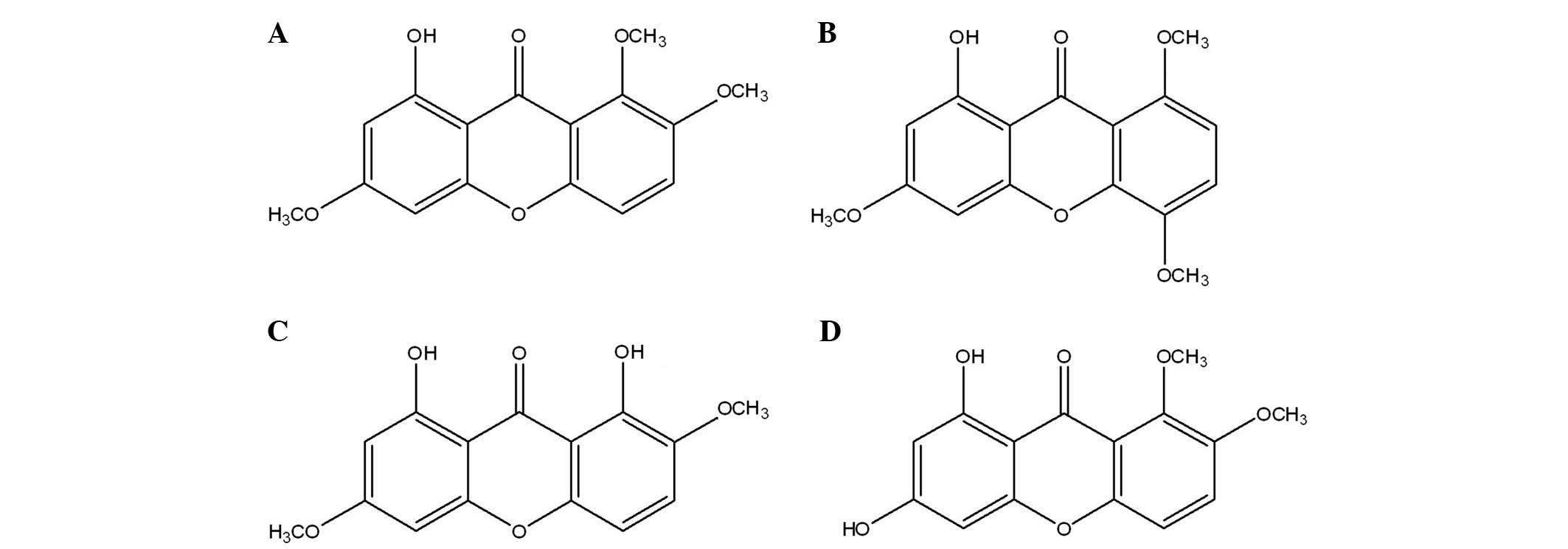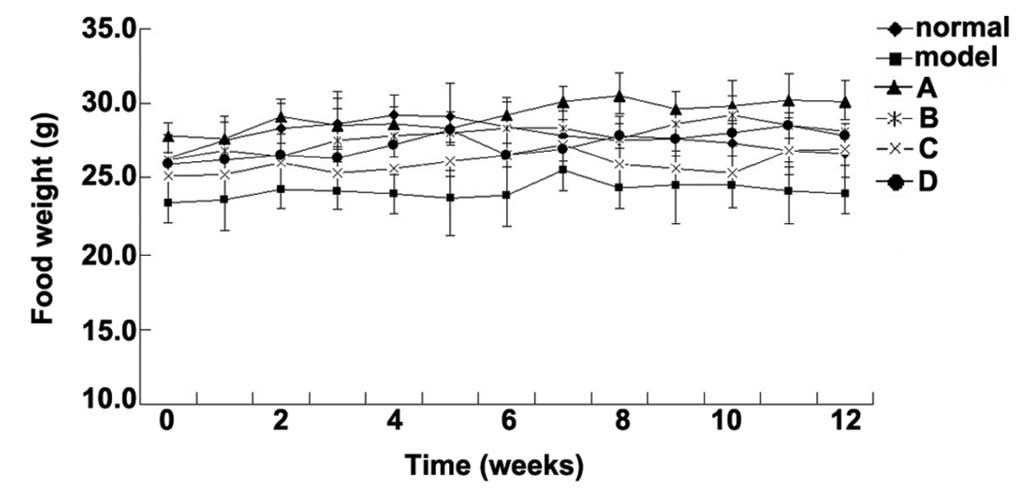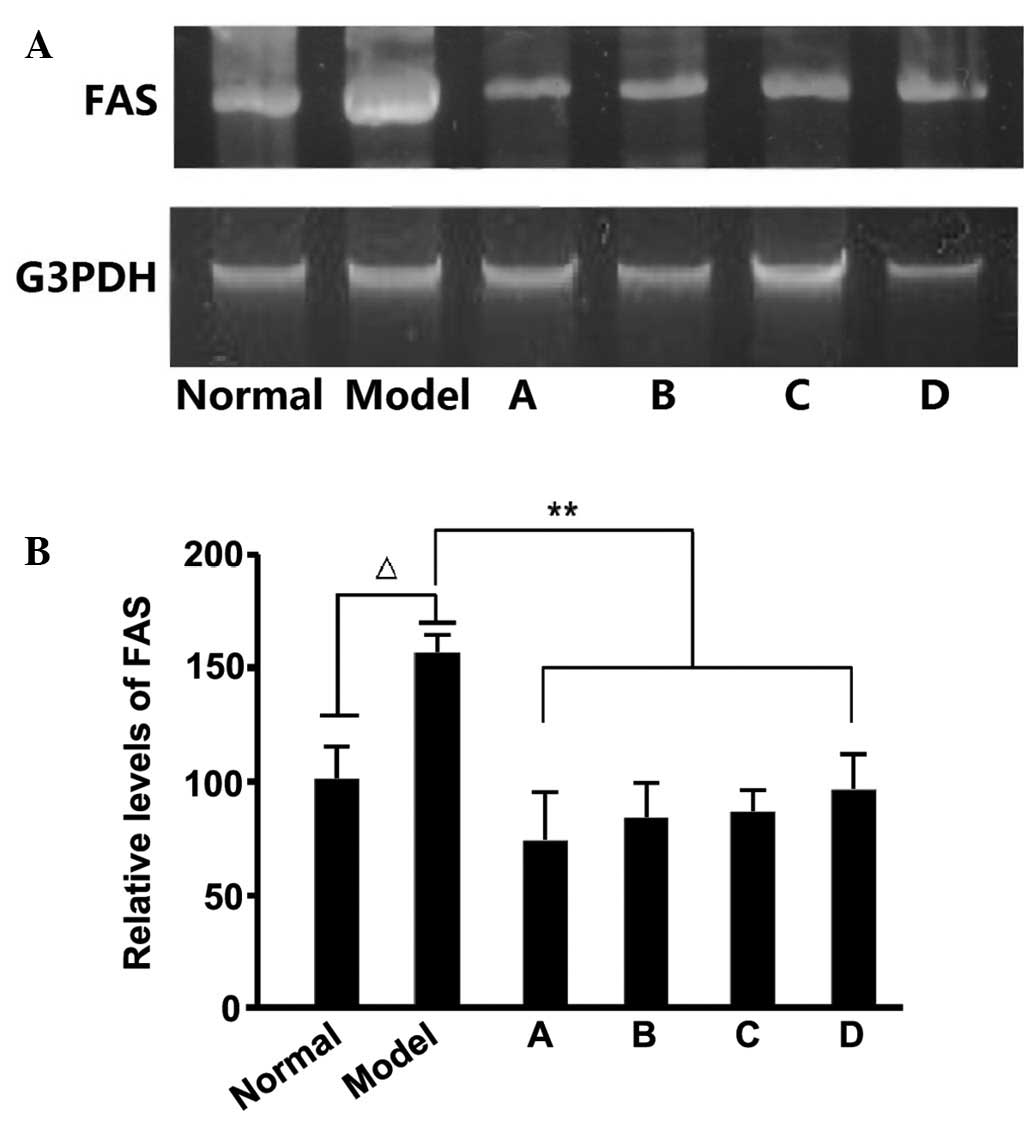|
1
|
Li YL, Suo YR, Liao ZX and Ding LS: The
glycosides from Lomatogonium rotatum. Nat Prod Res.
22:198–202. 2008. View Article : Google Scholar : PubMed/NCBI
|
|
2
|
Zhao N, Wang M and Li XE: Biological
macro-idea and criterion of osteopathic fracture immobilization in
China's traditional Mongolian medicine. J Tradit Chin Med.
32:114–118. 2012. View Article : Google Scholar : PubMed/NCBI
|
|
3
|
Burie: Preliminary study on classification
and nomenclative system of Mongolian traditional medicine. Zhong
Guo Zhong Yao Za Zhi. 36:1539–1541. 2011.(In Chinese).
|
|
4
|
Li ZH, Zhang AH, Yun XH, Zhang CH, Zhu SD,
Zou DZ, Bi YQ and Li MH: Ecology suitability study of Lomatogonium
rotatum in Inner Mongolia. Zhong Guo Zhong Yao Za Zhi. 40:778–784.
2015.(In Chinese).
|
|
5
|
Schultz A, Barbosa-da-Silva S, Aguila MB
and Mandarim-de-Lacerda CA: Differences and similarities in hepatic
lipogenesis, gluconeogenesis and oxidative imbalance in mice fed
diets rich in fructose or sucrose. Food Funct. 6:1684–1691. 2015.
View Article : Google Scholar : PubMed/NCBI
|
|
6
|
Huang HC and Lin JK: Pu-erh tea, green
tea, and black tea suppresses hyperlipidemia, hyperleptinemia and
fatty acid synthase through activating AMPK in rats fed a
high-fructose diet. Food Funct. 3:170–177. 2012. View Article : Google Scholar : PubMed/NCBI
|
|
7
|
Hada DS, Garg S, Ramteke GB and Ratre MS:
Effect of Nonsurgical Periodontal Treatment on Clinical and
Biochemical Risk Markers of Cardiovascular Disease: A Randomized
Trial. J Periodontol. 86:1–16. 2015. View Article : Google Scholar : PubMed/NCBI
|
|
8
|
Pant N, Jain DC and Bhakuni RS: Some
chemical constituents of Swertia chirata. Indian J Chem B.
41:1980–1986. 2002.
|
|
9
|
Jia J, Chen T, Wang P, Chen G, You J, Liu
Y and Li Y: Preparative separation of methylswertianin, swerchirin
and decussatin from the Tibetan medicinal plant Swertia
mussotii using high-speed counter-current chromatography.
Phytochem Anal. 23:332–336. 2012. View
Article : Google Scholar : PubMed/NCBI
|
|
10
|
Chakravarty AK, Mukhopadhyay S, Moitra SK
and Das B: Syringaresinol, a hepatoprotective agent and other
constituents from Swertia chirata. India J Chem B.
33:405–408. 1994.
|
|
11
|
Wang J, Liu Y, Cai Y, Zhang F, Xia G and
Xiang F: Cloning and functional analysis of geraniol
10-hydroxylase, a cytochrome P450 from Swertia mussotii
Franch. Biosci Biotechnol Biochem. 74:1583–1590. 2010. View Article : Google Scholar : PubMed/NCBI
|
|
12
|
Chiba K, Yamazaki M and Kikuchi M, Kakuda
R and Kikuchi M: New physiological function of secoiridoids:
Neuritogenic activity in PC12h cells. J Nat Med. 65:186–190. 2011.
View Article : Google Scholar : PubMed/NCBI
|
|
13
|
Lv Y, Zhang HT, Wang YF, Zhu H, Long P,
Wang ZW, Zhang N and Zhang CH: Preliminary comparative study of
swertiamarin and swertisin on three kinds of Digeda-species
Mongolian medicinal materials. Zhong Guo Zhong Yao Za Zhi.
40:804–806. 2015.(In Chinese).
|
|
14
|
Marques MB, Ribeiro-Oliveira A Jr,
Guimarães J, Nascimento GF, Anjos AP, Vilas-Boas WW, Santos RA,
Thomas JD, Igreja SM, Grossman AB, et al: Modifications in basal
and stress-induced hypothalamic AMP-activated protein kinase (AMPK)
activity in rats chronically treated with an angiotensin II
receptor blocker. Stress. 15:554–561. 2012. View Article : Google Scholar : PubMed/NCBI
|
|
15
|
Alaribe CS, Shode F, Coker HA, Ayoola G,
Sunday A, Singh N and Iwuanyanwu S: Antimicrobial activities of
hexane extract and decussatin from stembark extract of Ficus
congensis. Int J Mol Sci. 12:2750–2756. 2011. View Article : Google Scholar : PubMed/NCBI
|
|
16
|
Reddy SS, Ramatholisamma P, Karuna R and
Saralakumari D: Preventive effect of Tinospora cordifolia
against high-fructose diet-induced insulin resistance and oxidative
stress in male Wistar rats. Food Chem Toxicol. 47:2224–2229. 2009.
View Article : Google Scholar : PubMed/NCBI
|
|
17
|
Uluışık D and Keskin E: Effects of ginseng
and echinacea on cytokine mRNA expression in rats.
ScientificWorldJournal. 2012:9420252012. View Article : Google Scholar : PubMed/NCBI
|
|
18
|
Moura LP, Figueredo GA, Bertolini NO,
Ceccato M, Pereira JR, Sponton AC and de Mello MA: Dietary
restriction, caloric value and the accumulation of hepatic fat.
Lipids Health Dis. 11:2012. View Article : Google Scholar : PubMed/NCBI
|
|
19
|
Li Y, Yang H, Han WW, Liao MX and Lu YQ:
An enzyme sensor for phenolic compounds analysis. Guang Pu Xue Yu
Guang Pu Fen Xi. 30:571–574. 2010.(In Chinese). PubMed/NCBI
|
|
20
|
Araújo AN, Lima JL, Pinto PC and Saraiva
ML: Enzymatic determination of glucose in milk samples by
sequential injection analysis. Anal Sci. 25:687–692. 2009.
View Article : Google Scholar : PubMed/NCBI
|
|
21
|
Shahzad F, Tawwab S and Ahsan U: Lipid
profiles of non-diabetic healthy and ischaemic heart disease
patients. J Coll Physicians Surg Pak. 23:242–246. 2013.PubMed/NCBI
|
|
22
|
Leguit P Jr: Compartment syndrome of the
upper arm. Neth J Surg. 34:123–126. 1982.PubMed/NCBI
|
|
23
|
Wang X, Li S and Zhou Z: A rapid one-step
method of EIA for detection of circulating antigen of
Schistosoma japonicum. Chin Med J (Engl). 112:124–128.
1999.PubMed/NCBI
|
|
24
|
Diraison F, Pachiaudi C and Beylot M: In
vivo measurement of plasma cholesterol and fatty acid synthesis
with deuterated water: Determination of the average number of
deuterium atoms incorporated. Metabolism. 45:817–821. 1996.
View Article : Google Scholar : PubMed/NCBI
|
|
25
|
Reddy SS, Ramatholisamma P, Ramesh B,
Baskar R and Saralakumari D: Beneficiary effect of Tinospora
cordifolia against high-fructose diet induced abnormalities in
carbohydrate and lipid metabolism in Wistar rats. Horm Metab Res.
41:741–746. 2009. View Article : Google Scholar : PubMed/NCBI
|
|
26
|
Barbosa CR, Albuquerque EM, Faria EC,
Oliveira HC and Castilho LN: Opposite lipemic response of Wistar
rats and C57BL/6 mice to dietary glucose or fructose
supplementation. Braz J Med Biol Res. 40:323–331. 2007. View Article : Google Scholar : PubMed/NCBI
|
|
27
|
Shrestha S, Ehlers SJ, Lee JY, Fernandez
ML and Koo SI: Dietary green tea extract lowers plasma and hepatic
triglycerides and decreases the expression of sterol regulatory
element-binding protein-1c mRNA and its responsive genes in
fructose-fed, ovariectomized rats. J Nutr. 139:640–645. 2009.
View Article : Google Scholar : PubMed/NCBI
|
|
28
|
Collino M, Aragno M, Castiglia S, Miglio
G, Tomasinelli C, Boccuzzi G, Thiemermann C and Fantozzi R:
Pioglitazone improves lipid and insulin levels in overweight rats
on a high cholesterol and fructose diet by decreasing hepatic
inflammation. Br J Pharmacol. 160:1892–1902. 2010. View Article : Google Scholar : PubMed/NCBI
|
|
29
|
Chintalwar GJ and Chattopadhyay S:
Structural confirmation of decussatin, a Swertia decussata
xanthone. Nat Prod Res. 20:53–56. 2006. View Article : Google Scholar : PubMed/NCBI
|
|
30
|
Frangioudakis G, Gyte AC, Loxham SJ and
Poucher SM: The intravenous glucose tolerance test in cannulated
Wistar rats: A robust method for the in vivo assessment of
glucose-stimulated insulin secretion. J Pharmacol Toxicol Methods.
57:106–113. 2008. View Article : Google Scholar : PubMed/NCBI
|
|
31
|
Zhang X, Zhao Y, Zhang M, Pang X, Xu J,
Kang C, Li M, Zhang C, Zhang Z, Zhang Y, et al: Structural changes
of gut microbiota during berberine-mediated prevention of obesity
and insulin resistance in high-fat diet-fed rats. PLoS One.
7:e425292012. View Article : Google Scholar : PubMed/NCBI
|
|
32
|
Zhao YX, Liang WJ, Fan HJ, Ma QY, Tian WX,
Dai HF, Jiang HZ, Li N and Ma XF: Fatty acid synthase inhibitors
from the hulls of Nephelium lappaceum L. Carbohydr Res.
346:1302–1306. 2011. View Article : Google Scholar : PubMed/NCBI
|
|
33
|
Kim GS, Park HJ, Woo JH, Kim MK, Koh PO,
Min W, Ko YG, Kim CH, Won CK and Cho JH: Citrus aurantium
flavonoids inhibit adipogenesis through the Akt signaling pathway
in 3T3-L1 cells. BMC Complement Altern Med. 12:312012. View Article : Google Scholar : PubMed/NCBI
|
|
34
|
Hwang Pil Y, Kim Gyun H, Choi JH, Do
Truong M, Tran TP, Chun HK, Chung YC, Jeong TC and Jeong HG:
3-Caffeoyl, 4-dihydrocaffeoylquinic acid from Salicornia herbacea
attenuates high glucose-induced hepatic lipogenesis in human HepG2
cells through activation of the liver kinase B1 and silent
information regulator T1/AMPK-dependent pathway. Mol Nutr Food Res.
57:471–482. 2013. View Article : Google Scholar : PubMed/NCBI
|
|
35
|
Do MT, Kim HG, Choi JH, Khanal T, Park BH,
Tran TP, Hwang YP, Na M and Jeong HG: Phillyrin attenuates high
glucose-induced lipid accumulation in human HepG2 hepatocytes
through the activation of LKB1/AMP-activated protein
kinase-dependent signalling. Food Chem. 136:415–425. 2013.
View Article : Google Scholar : PubMed/NCBI
|
















